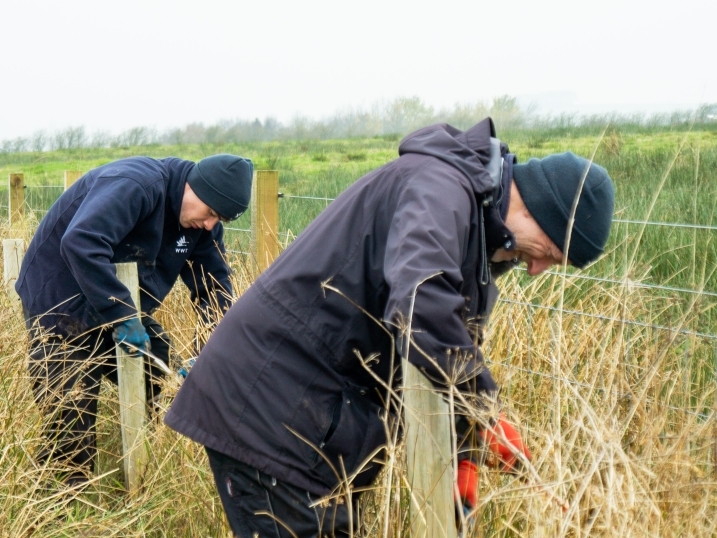From keyboard clacker to chainsaw wielder: The Wilder, Wetter Caerlaverock Diaries no.7

The Wilder, Wetter Caerlaverock project involves lot of working at my desk. When I am out on site, usually I’m prepping further project work: clipboard in hand, monitoring habitat changes and managing contractors. It’s rewarding working on largescale habitat restoration but coming from a wardening background, I’d be lying if I said that I didn’t sometimes miss getting dirty with some hands on habitat work. But, this month I’ve had the opportunity to unleash my practical side.
One task I’ve jumped into is some fence removal in one of the compartments on the northern part of the reserve. We’re looking to remove the fence line because, in short, some new fence has been put in and we want to combine two smaller compartments into one larger area. It hasn’t been grazed in a while and so the reedbed nearby has expanded.
At the time of writing, we’ve removed about 500m of fencing from here with quite a way still to go but the volunteers and reserve team have been working really hard on it and getting through it quickly! Working by this expanding reedbed is not bad: the call of water rail serenading (also known as screeching) us while we work
But it’s not just fences! In an area we are improving for natterjack toads (and biodiversity more generally), we are clearing gorse and burning the cuttings. This spot is known to us as ‘Gorse Fields’. It has had sporadic grazing for quite some time and so not only is the sward tall and rank in areas but the gorse there has expanded to an estimated 70% of the compartment. One of our project aims is to reduce that to 50% which we’re doing by cutting out blocks of gorse with chainsaws.

a gorse burn
At first I must admit, it was quite daunting deciding where to start as there’s just so much gorse. But we can envision what Gorse Fields might look like and from there, decide what to remove. Essentially we are focussing on clearing areas for pond creation, connecting existing ponds and using sheep to help graze these areas and we are breaking up any dense patches of gorse.
It’s sweaty work as the PPE is thick and moving across the ground is always something you have to be careful of, with hidden gorse branches and stumps at every turn. With that being said it’s one of my favourite practical tasks. Not only am I already seeing the benefits of the work we’re doing and the vision of Gorse Fields becomes clearer but it is one of my favourite spots on the reserve and it’s incredibly peaceful! Visitors don’t have access to this particular area and when you’re amongst the gorse you can’t see many of the regular features of the reserve like the hides. When the chainsaws aren’t wurring away, the only accompanying noises are overhead geese, passerines like linnets flitting amongst the scrub and birds using the nearby saltmarsh – usually lapwing and golden plover.
I can’t overstate how important the reserve team and our wonderful volunteers are for getting some of these project targets hit. By the end of winter we’ll have removed close to 1000m of unwanted fence line and opened up close to 1500m2 in Gorse Fields and they deserve a big thank you for the vital work they put in, as well as their tolerance of my out-of-practice, map-scrutinising, keyboard-clacking self.
This project is supported by the Scottish Government’s Nature Restoration Fund, managed by NatureScot.
Words by Jake Goodwin
Feature image of volunteers removing fence line by Jess Byers



